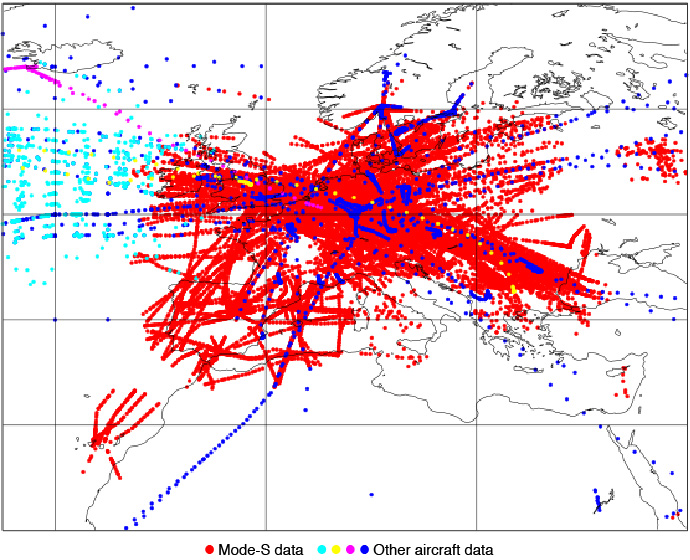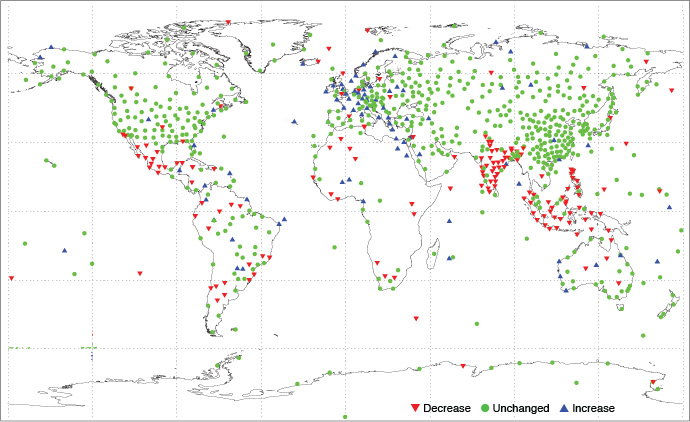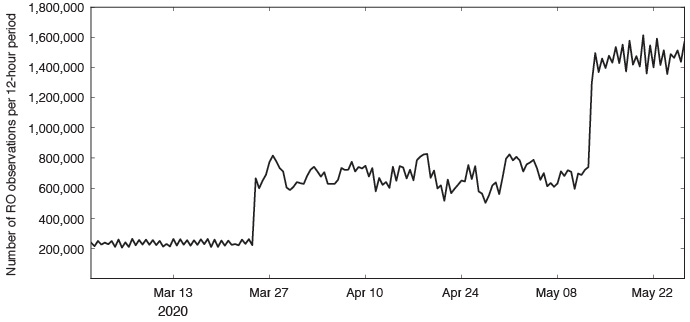

A coordinated response involving EUMETNET, national meteorological services and private companies is helping to mitigate any adverse effects of the continued loss of aircraft-based observations on weather forecasts.
Since March, due to the COVID-19 pandemic, there has been a sharp drop in flights and thus in the aircraft-based observations available to weather prediction centres.
Fortunately, EUMETSAT, ESA and other space agencies have continued to provide complete sets of satellite observations. These remain the most important observations, and their continued availability has ensured that there is no severe impact from the loss of aircraft observations.
Aircraft reports include temperature and wind and in some cases humidity and turbulence. They are used together with many other observations to help estimate the state of the Earth system at the start of forecasts.
Responses to the drop in observations include the use of previously untapped aircraft-based observations; an increase in the number of radiosonde launches from some locations; and the assimilation of additional satellite data.
In an example of successful collaboration with the private sector, the companies FLYHT and Spire have stepped in to provide additional aircraft-based observations and radio occultation satellite data, respectively.
The reduction
Between mid-March and mid-April, the number of aircraft reports received at ECMWF went down by about 75% before levelling out.
“There have even been very slight increases since, partly thanks to cargo flights,” says ECMWF scientist Bruce Ingleby. “However, it has become clear that recovery will be slow, taking many months rather than weeks.”

Numbers of global aircraft reports received at ECMWF per day. The regular dips reflect reductions in the numbers at weekends. There is some thinning and a small proportion of rejections so that the number assimilated (green) is less than the number received (blue). Most reports are received as part of the WMO’s Aircraft Meteorological Data Relay (AMDAR) programme.
The impact
A data denial experiment run at ECMWF in 2019 suggested that removing all aircraft data has most impact at aircraft cruise levels (250–200 hPa or 10–12 km altitude). Here 12-hour wind and temperature forecasts became about 10% worse in the northern hemisphere extratropics.
At the surface, 3- or 4-day forecasts of mean sea level pressure deteriorated by about 3% on average.
“There is, however, no clear signal in ECMWF forecast verification over the last two months that can be linked to the decrease in aircraft numbers,” says Bruce. He gives three main reasons for this:
First, there is both day-to-day and seasonal variability in forecast skill, making it difficult to pin down the impact of reduced data availability.
Second, the impact per observation increases somewhat with reduced data density, so one would expect to see less than 75% of the ‘no aircraft’ impact from the current configuration.
Finally, additional data from a range of sources, partly made available in response to the drop in aircraft data, are helping to mitigate any detrimental effects.
The response
EUMETNET has played a key role in coordinating the response to the loss of data among its members.
“We have tried to act as quickly as possible to assess the impact of the COVID-19 restrictions on the European Composite Observing System (EUCOS) and put in place a coordinated mitigation plan amongst EUMETNET members,” says Bruce Truscott, the EUMETNET Observations Capability Area programme manager.
Part of the response has been to optimise and expand the use of aircraft observations that continue to be available:
- EUMETNET has changed its configurations to make the most of any flights that E-AMDAR-equipped aircraft make.
- In collaboration with EUMETNET and the UK Met Office, the company FLYHT has made its aircraft observations available for free for now. On 12 May, ECMWF started actively using some of these data, which fill some gaps.
- The European Meteorological Aircraft Derived Data Center (EMADDC) at the Dutch national meteorological service (KNMI) has been processing ‘Mode-S’ air traffic control signals to derive wind and temperature information. Following a recent meeting of experts, ECMWF has been working on processing the data and can now use them in a test version of the forecasting system.

Twelve-hour Mode-S data coverage in a test system. Processing of ‘Maastricht Area’ Mode-S data covering the Netherlands and adjacent areas has been operational at KNMI for some time. The figure shows Mode-S aircraft-based 12-hour observation coverage from 21 UTC on 9 May 2020 over a much wider area in a test system. After ECMWF thinning, only about 5% of Mode-S reports are shown.
“Clearly, for the areas where Mode-S is available this source dominates all others,” says Bruce Ingleby. “Following a formal agreement with EMADDC and further technical work, we hope to start operational monitoring of Mode-S data in the next few weeks and assimilation soon after.”
Bruce Truscott adds that “we are working with numerical weather prediction centres, including ECMWF, to support their efforts to assess the quality of these data and integrate them into their operational data assimilation schemes.”
In other developments regarding in-situ weather observations:
- Coordinated by EUMETNET, several of its members have increased the frequency of radiosonde ascents from some of their stations. However, as the figure below shows, in some other places the number of radiosonde ascents has dropped, perhaps due to supply difficulties.
- As part of a longer-term study, ECMWF is looking at the quality and possible assimilation of radiosonde descent data (after balloon burst).
- In some areas, the number of surface reports from airfields (METARs) has gone down.
- In general, SYNOP weather station reports have stayed relatively constant.

Radiosonde report availability. The chart compares the availability of radiosonde reports in May with that in March 2020.
At ECMWF, in normal times aircraft reports are second only to satellite data in their impact on forecasts. There are several recent additions to the satellite data assimilated at ECMWF which can help to make up for the loss of aircraft data:
- In 2019, ECMWF started assimilating data from several important instruments onboard EUMETSAT’s Metop-C satellite.
- In January, ECMWF began to assimilate wind observations from ESA’s ground-breaking Aeolus satellite.
- In March, the Centre started to use GNSS radio occultation (GNSS-RO) measurements from the FORMOSAT-7/COSMIC-2 mission, increasing the number occultation profiles available for operational assimilation from around 3,000 a day to around 8,000.
- In mid-May, the number of occultations rose again by another 5,000 profiles a day when ECMWF began to assimilate RO data from the data and analytics company Spire.
Spire had offered to provide its RO observations free of charge for now to help mitigate the loss of aircraft data. Building on previous work on the data by ESA, EUMETSAT and the UK Met Office, ECMWF was able to quickly move from quality assessment and passive monitoring to active assimilation.

Number of radio occultation observations assimilated at ECMWF. The numbers shown in the chart are for individual observations. Each RO vertical profile contains between 250 and 300 such observations, which provide information on temperature and humidity. The step changes at the end of March and in mid-May mark the start of assimilating COSMIC-2 and Spire data, respectively.
“The additional RO data have improved forecasts against a range of metrics,” says ECMWF scientist Chris Burrows. “In terms of the relative impact of different types of observations on forecasts, since the end of March aircraft-based observations have gone down substantially and RO data have gone up in broadly equal measure.”
